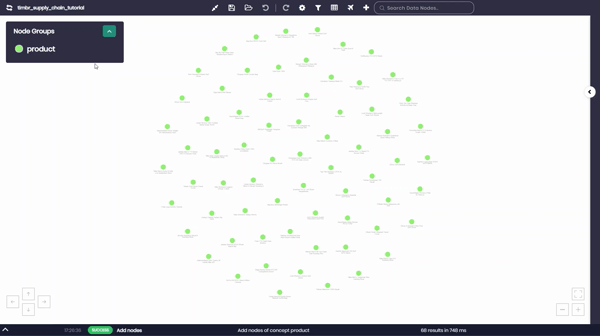ontologies' consumption
REST API & Semantic Swagger
Timbr’s REST API enables applications and autonomous AI agents to consume data through the ontology’s business concepts.
It combines the simplicity of REST with the precision and flexibility of GraphQL-like querying, and goes a step further by auto-generating a complete, interactive Swagger specification for every semantic model.
Key Capabilities
Semantic, AI Agents’ READY Data Access
Timbr exposes data through concept endpoints derived from your ontology. Applications ask for Customer, Order, or Product with domain-aware filters, no need to reference physical tables.
Nested
Data Traversal
Retrieve deeply connected information, including related entities like Order → Product → Supplier, in a single request. The API understands your modeled relationships, so you don’t have to manage JOINs manually.
Precise Field
Selection
No Over-/Under-fetching: Specify exactly which properties you need using filters and query parameters, mirroring GraphQL’s precision but with REST simplicity.
Performance
Optimized
Timbr’s intelligent query engine optimizes nested queries and relationship traversal into efficient backend fetches, reducing network overhead and latency.
Enterprise-Grade Security
Built-in, row-level security, role-based access and JWT authentication ensure that REST responses respect your data governance policies.
What Every User of REST API
Should Know
Timbr REST api blends the best features of REST and GraphQL
Timbr REST API users benefit from simplified data access to one or more data sources, data integration, relationships, results nesting, expressive querying and enhanced security. These benefits ultimately lead to rapid development, improved performance, and easier maintenance of REST API applications.
Swagger Self-documenting API for every Semantic Model
Timbr integrates OpenAPI Swagger UI directly atop ontology models. Every model concept auto‑generates REST endpoints, complete with filters, paging, and nested queries. This self‑documenting API ensures always‑up‑to‑date, interactive metadata, empowering data teams to explore and consume data effortlessly.
How it Works
Data Fetching
Timbr REST API allows clients to specify exactly which fields they need in a single request, avoiding over-fetching or under-fetching of data.
Relationship Handling
Timbr REST API excels in handling complex relationships between data entities. It provides mechanisms to traverse relationships, perform filtering, and specify related data to include in the response.
Performance
Timbr REST API performance is better than REST API’s performance because data is fetched in a single call, reducing network payload.
Security
Timbr REST uses HTTP-based authentication and up to row level data access control for enhanced security.
Use cases
Timbr REST can be used in any type of application and excels in complex queries.
Data Aggregation
Timbr REST API allows clients to fetch data from multiple resources in a single request, enabling efficient data aggregation. It can integrate with multiple underlying REST services, combine their responses, and provide a unified view to clients. This reduces the number of round trips required to fetch related data, improving efficiency.
Nested Queries
Timbr REST API allows clients to define the shape of the response data by specifying nested fields and their relationships. Users can map the response to a GraphQL-like structure, providing clients with a flexible and consistent data shape.
Error Handling
Timbr REST depends on HTTP status codes and JSON for communicating errors, providing much better feedback.
Learning Curve
A moderate learning curve in comparison to GraphQL
Comparison with GraphQL
| | GraphQL | REST | Timbr REST |
|---|---|---|---|
| Server Access | schema based | endpoints | schema based + endpoints |
| Operations | queries, mutations, subscriptions | create, read, update, delete | read + SQL queries |
| Data Fetching | specific data on single call | fixed data on multiple calls (over-fetching and under-fetching) | specific data on single call |
| Query Nesting | in a single call | multiple calls | in a single call |
| Performance | fastest | multiple calls decrease performance | fast |
| Learning Curve | slow (ad-hoc syntax and logic) | moderate | fast |
| Shareability | self documenting | depends on implementation | shareable semantic model |
| Stability | predictable results, automatic validation and type checking | better choice for complex queries | predictable results, automatic validation and type checking for complex queries |
| Recommended for | applications requiring rapidly-changing data, complex systems and microservices | applications using few fields repeatedly | applications requiring simple data access from one or more datasources |
Add Semantic Swagger to Your APIs
- Receive Automatic Updates: Receive automatic updates to reflect every creation and minute change made to the knowledge graph.
- Seamlessly Understand Data: Seamlessly understand the data’s structure, relationships, available filters, and operations like “GET” and “POST”.
- Utilize Latest Versions: Utilize the latest versions of your applications or analyses. No more waiting for manual documentation to catch up.
- Enjoy REST Endpoints: Enjoy REST endpoints that are automatically generated for every concept modeled in the knowledge graph.
- Manage Large Data Sets: Manage large sets of data results with consistent paging patterns across all URLs with swaggers implemented pagination support.
- Improve Query Performance: Improve query performance and reduce network overhead with Swaggers support of nested queries and efficient traversal of interconnected data structures.
Key Benefits for Data Consumers
- Clarity: Access business concepts like Customer, Transaction, or Product directly, no need to understand raw schemas or table joins.
- Precision: Fetch exactly the fields you need, including nested and related entities, all in one optimized request.
- Simplicity: Use intuitive RESTful URLs and filters that reflect your semantic model, with no need for complex payload construction.
- Efficiency: Save time and bandwidth, Timbr handles query planning and optimization behind the scenes.
- Security: Enforce role-based access and row-level controls via JWT authentication, without embedding logic into your apps.
